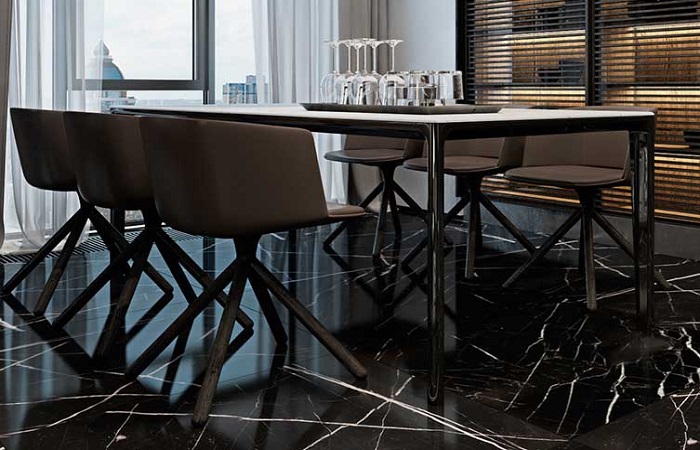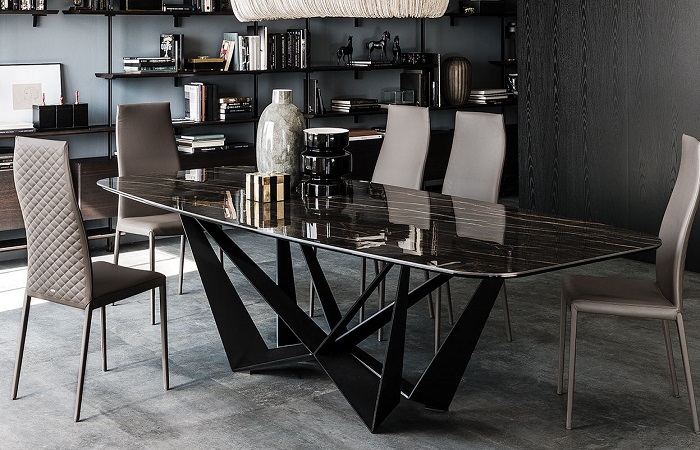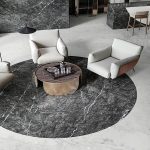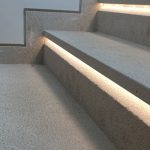Vast Majority of Black Marble Types

Vast Majority of Black Marble Types
Vast majority of black marble types are to be discussed here. Marble is easily one of the most luxurious natural stones. This is especially true considering how many different types there are. The natural beauty of this raw stone makes it a versatile choice for any indoor or outdoor remodeling ideas.
Black Marble
Black marble is widely used for floors, claddings and countertops, and even as complements for furniture. Of course it is not the only kind of marble used for that kind of applications; however, it is undeniable that black marble always gives a touch of elegance and exclusivity to any environment.
Black Limestones or Dolomites
There are many types of black marble on the market, the vast majority are black limestones or dolomites whose surface acquires shine after polishing. The black color of this type of stone is mainly explained by its genesis on continental platforms that have received an important volume of sediments with abundant organic matter and carbonate under anoxic conditions.
Seven Types of Black Marble
We have selected for this post, seven types of Black Marble from a broad array of black stones. That selection is based on our experience in the Stone sector attending to criteria of demand, the existence of active quarries, aesthetic preferences of the final client and prescriptors (interior designers and architects), technical characteristics and availability in the market.

Marquina Marble or Black Marquina, Spain
Marquina Marble is possibly the most well-known black marble worldwide, due to the intensity and homogeneity of its black background, its characteristic white veins and its high volumen of production. It is a black reef limestone with fine grain and very typical calcite white veins. It is extracted from the quarries of Markina (Biscay), Spain. The main characteristics of this stone are:
Fine grain.
With fossils/occasionally.
Dark grey/Black background
White veins of irregular thickness
Noir Saint Laurent Marble, France
The Noir St Laurent marble is a black limestone of fine grain with golden brown veins and white inlays. It is extracted in Laurens, France since 1885. From the petrographic point of view, this black marble it is a bioclastic limestone, with a microsparite texture, attributed to the Devonian (Eifelian – Givetian). It is a compact carbonatic material, with light gray to black background barely karstified.
Its mains characteristics are:
Fine grain.
With fossils/occasionally.
Dark grey/Black background
Golden and white irregular veins
Port St Laurent, Morocco
Nero Port Saint marble is a brown dark grey limestone with fine grain and golden calcite veins that shines when polished. The quarry is located in the area of Agadir-Biougra, it is a Meosozoic material and it is found at the limit between two carbonate platforms of the High Atlas and Anti Atlas. The main characteristics of this marble are:
Fine grain.
With fossils/occasionally.
Dark grey to black background slightly clearler than the previously mentioned black marble.
Golden and white veins, much more frequent than the mentioned above
Fossil Black, Morocco
The Fossil Black marble is a black/dark grey limestone of medium/thick grain with a large number of fossils with shell such as the Ammonites Goniatites and Orthoceras, which are located in the Upper Devonian Period.
The quarry from which it is extracted is located in the area of Erfoud, Morocco. These limestones were deposited during the Devonian period as we have already mentioned. Due to different natural factors, fish, plants and other ancient marine fossils such as ammonites and orthoceras were accumulated in this area under anoxic conditions. Later, these materials would emerged due to different tectonic shifts and the sea withdrawal.
The main characteristics of this type of black marble:
Medium/thick grain
High fossil content: Ammonites and Orthoceras mainly
Dark grey to black matrix or background
Very characteristic white veins and fossils
Nero Dorato or Sahara Noir Marble, Tunisia
The Black Marble of Tunisia called Nero Dorato is also known as Nero Sahara, Sahara Noir, Black Aziza Marble, Nero Tunisi, Nero Berber, etc. It is located in the Zaghouan area in northeast Tunisia, 60 km south of Tunis. This stone is a micritic limestone with ooliths and plantonical foraminifera. Its color range from grey to black with white veins of calcite recrystallization but also brown and golden colors.
The main characteristics of the Nero Dorato marble are:
Fine/very fine grain
With occasional fossils
Very dark grey to black background
White and/or brown/gold calcite recrystallization veins.
Nero Portoro, Italy
The Nero Portoro is an Italian marble. It’s considered one of the most luxurious marble in the world. It has been well know and used from antiquity when it was extracted manually during the 7th and 8th centuries.
It is a black micritic limestone with golden veins containing limonite and sulphides. The composition is mainly of calcite and dolomite as secondary. Its black color comes from organic matter, bitumen and sulphides deposited in an anaerobic conditions. The quarries are located on the outskirts of the city of La Spezia, and are geologically framed within the Portovenere limestone formation of the Tuscany foothills belonging to the Upper Triassic – Lower Cretaceous
The main characteristics of the Nero Portoro are:
Fine grain
With occasional fossils
Very intense black background
Very characteristic golden streaks with wavy shape and irregular filling
Black and Gold, Pakistan
Black and Gold is a black marble found in the mountains of Balochistan, province located in the south-west of Pakistan. In this area are also extracted other natural stones such as Onyx and Granite. The main characteristics of this marble:
Fine grain
Total absence of fossils, as it’s geologically a marble (fossils disappear in the process of metamorphism)
Intense black background
Gold and white veins
The white ones are more abundant in inferior qualities.
Other Varieties of Black Marbles
As we mentioned at the beginning, the types of marbles described above are the best known and most demanded worldwide.
Even so, there are many other kinds of Black Marble such as:
Kawala Nero (Greece)
Crete Nero (Greece)
Nero di Ormea (Italy)
Austral Gold (Australia)
Ruivina (Portugal)
Petit Granit (Belgium)
Black Pearl (Turkey)
Black Magic (Turkey)
Portoro Antalya (Turkey)
Black Marble Applications
It’s very frequent to see Black Marble recommended for flooring by manufacturers. However we have to point out that black marble is generally softer than white, beige, etc and therefore more susceptible to scratching and erosion by its use. For this reason, it is not recommended to use them in pavements especially in high traffic areas such as commercial areas. It’s used to be combined with other lighter colored marbles, especially with the white ones. Well spread all over the world is the precious black and white checkerboard arrangement. They combine very well with light tones, beiges, cream, light greys, etc.
To learn more about us, click here.
Send your price quotes directly to our WhatsApp through this Link: https://wa.link/ord5k8
Sources
alborainternational.com/en/types-black-marble-floors-counters-cladding/
sebringdesignbuild.com/types-of-marble/
- Back To Articles
- Austral Gold (Australia), Avid Dark Grey Marble, Black and Gold, Black Limestones or Dolomites, Black Magic (Turkey), black marble, Black Pearl (Turkey), Chenaran Grey Marble, Crystal Gray Marble, Damasta Silver Grey, Dark Emotion, Emotion Marble, Fossil Black, France, grey marble, Grey Marble Dark, Grey Mocha Marble, Gris Sahara Marble, Heten Marble, Italy, Laurent grey marble, Lillia Gray Marble, Marquina Marble or Black Marquina, Morocco, Nero Crete (Greece), Nero di Ormea (Italy), Nero Dorato or Sahara Noir Marble, Nero Kawala (Greece), Nero Portoro, New Castle Grey Marble, New Cyprus Grey, Noir Saint Laurent Marble, Other Varieties of Black Marbles, Pakistan, Pasa Grey Marble, Pascale Grey, Petit Granit (Belgium), Port St Laurent, Portoro Antalya (Turkey), Prestige Grey Marble, Ruivina (Portugal), Seven Types of Black Marble, Spain, Supreme Grey Marble, Tunisia, Vast Majority of Black Marble Types, Wyndham Grey Marble
Article
Natural Stone Applications
- 22 December 2022
Iranian Stones Introduction According to Source and Quarry
- 21 December 2022
Technical Stone Introduction and Quarrying Procedures
- 21 December 2022
Categories
- blog757
- news1
- Specialized articles756













